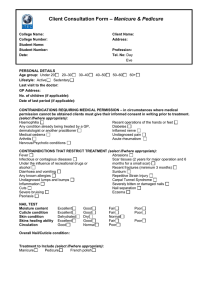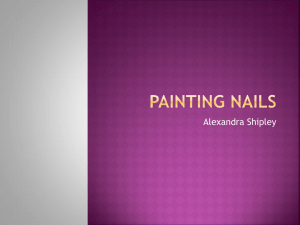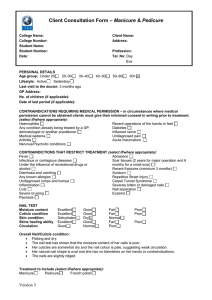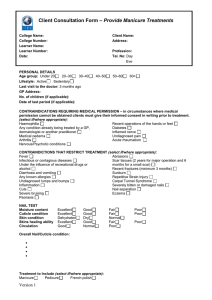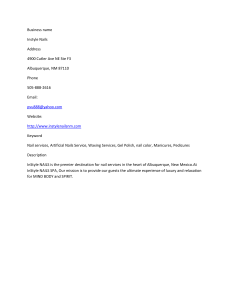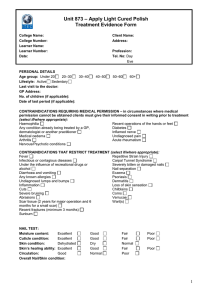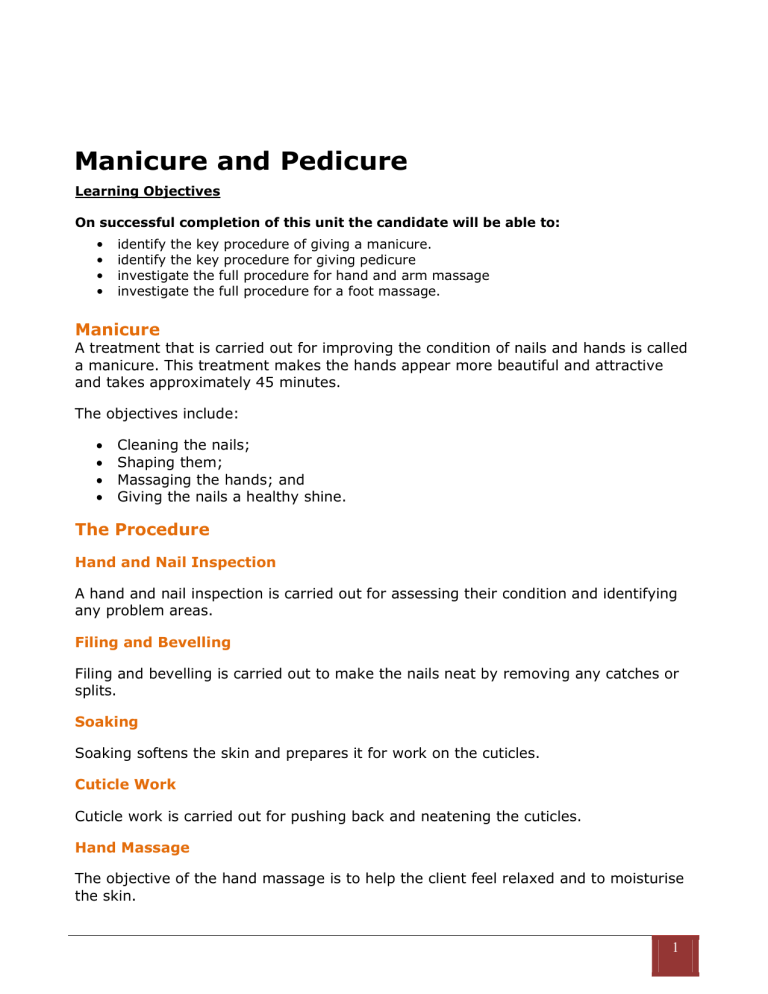
Unit 8 Manicure and Pedicure Learning Objectives On successful completion of this unit the candidate will be able to: • • • • identify the key procedure of giving a manicure. identify the key procedure for giving pedicure investigate the full procedure for hand and arm massage investigate the full procedure for a foot massage. Manicure A treatment that is carried out for improving the condition of nails and hands is called a manicure. This treatment makes the hands appear more beautiful and attractive and takes approximately 45 minutes. The objectives include: Cleaning the nails; Shaping them; Massaging the hands; and Giving the nails a healthy shine. The Procedure Hand and Nail Inspection A hand and nail inspection is carried out for assessing their condition and identifying any problem areas. Filing and Bevelling Filing and bevelling is carried out to make the nails neat by removing any catches or splits. Soaking Soaking softens the skin and prepares it for work on the cuticles. Cuticle Work Cuticle work is carried out for pushing back and neatening the cuticles. Hand Massage The objective of the hand massage is to help the client feel relaxed and to moisturise the skin. 1 Buffing Buffing makes the ridges smooth. Painting Painting beautifies the nails by adding shine and colour. Tip: For thin and long fingers, choose a square or rounded shape for the nails, keeping their length short. For short and fat fingers, nails can be filed to make them an oval shape. The length of the nails should preferably be longer. Consultation A consultation is essential before performing a manicure to evaluate the condition of a client’s nails, cuticles and skin so that the most suitable products and equipment can be selected. Assessing the Hands Start by examining the front and back of each hand. Is the skin thick or thin, or pale? Are the hands hard or soft, smooth or rough? Is the skin healthy or does it have any signs of an infection? Examine the skin between fingers to check if there are any symptoms of dryness. 2 5. Look at the skin between fingers 1. Examine the front and backs of the hands . 4. Does the skin show any signs of infections? 2. Look at colour and texture of the skin. 3. Are the hands soft and smooth or rough and chapped? Assessing the Nails What is the shape of the nails? Are the nails strong? Do the nails display any signs of a disorder or disease? What is the length of the nails? 1. What shape are the nails? 4. Do nails show the any signs of diseases or disorder? . 3. Are the nails healthy, strong and shiny? Or yellow, weak and thin? 2. What length are the nails? 3 Assessing the Cuticles Do the cuticles look hard? Are they overgrown? Are they smooth? Is the growth of the cuticles coming onto the nail plate? 1. Are the cuticles hard and overgrown or smooth and even? 3. Are there any hang nails? 2. Have the cuticles grown along the nail plate? When Not to Carry Out a Manicure A manicure should not be carried out if any of the following are discovered: Bruises; Cuts; or Severe damage in the nails. Materials, Products and Equipment Sterilised tools placed in a jar with antiseptic. A container for the client’s jewellery. A manicure bowl with soapy, warm water. Tissues and cotton wool. Nail file. The required products – cuticle cream, nail polish remover, massage cream, moisturiser and nail polish colours. Buffers. Nail scissors. Buffing paste. 4 The Manicure Procedure Use an antiseptic to wipe the back and front of the client’s hands. Roll up the client’s sleeves right up to the elbows, tucking tissues on the sleeve ends. Any nail polish on the nails should be removed. File the nails on the left hand and buff them. Apply cuticle cream on the cuticles. 5 The left hand will now be placed in the manicure bowl with antiseptic liquid soap and warm water. Repeat the same steps with the right hand. Take the left hand away from the manicure bowl and dry it, using a towel. Now put the right hand in the bowl. Apply the cuticle remover and use a cotton wool tipped stick to push back the cuticles on the left hand. Use cotton wool to wipe the nails. After applying cuticle oil, massage the nails using your thumbs. Both hands should be massaged next. Use cotton wool that has been soaked in nail polish remover to remove any grease on the nail plate. Apply nail polish. 6 Apply the base coat once. Apply the polish twice. Apply the top coat once. For clients who do not want a nail polish application, use the buff with a paste to add shine. Alternatively, you may use a four-sided buffer. Procedure Spiral for Manicure 1. Consultation 9. Painting or buffing 2. Check for infection 8. Massage and moisturise 7. Cuticle work 6. Soak 3. Remove varnish 4. File and bevel 5. Cuticle massage cream 7 Nail Filing Use the fine side of the emery board to file the nails. Never use the saw in both directions because this will make the nails split. The file should be used with a side to centre action at a 45 degree angle to the nail. The rougher and darker side should be used for removing excess length of the nails, while the smoother and lighter side should be used for removing rough edges and for shaping the nails. It is important to use a side to centre movement to file nails with the emery board slightly sloping below the free edge. Swift rhythmical strokes should be used. Cutting the Nails Nails should be cut with sterilised scissors. Use one hand to support the nail wall on the free edge of the nail being trimmed to minimise the client’s discomfort. The nails may be cut in a square, oval or pointed shape; however, the oval shape is generally recommended. Tip: While cutting nails, hold the nail plate quite firmly and support it well to avoid any injury to the nail. Buffing Buffers are made of chamois. They are used to shine the nail plate with the help of a buffing paste. Buffing has the following objectives: To provide the nail plate a gloss; To provide stimulation to the nail bed’s blood supply for a healthier growth of the nails; and To smooth any irregularities in the surface. Buffing Paste Buffing paste is a cream that is used for smoothing out irregularities in the surface, thus providing the nails a healthy shine. The abrasive particles contained in the buffing paste include talc, pumice or kaolin. Buffing should be performed after the nails have been filed and before they are soaked in the bowl. Buffing may be used as a polish also on a man’s nails. In case a buffing paste is being used, only a small quantity should be used. Apply it to the nail’s plate and spread it in downward strokes with your fingertips, starting from the cuticle and moving toward the free edge. Each nail should get six strokes. Cuticle Work Cuticle work is carried out to make the cuticle area more attractive and is done after the nails have been soaked in soapy, warm water to soften the cuticle area’s skin. 8 Procedure Remove the fingers from the soapy water and pat them with a towel. Apply the cuticle remover to the nail walls and the cuticle area with an applicator brush. Use a cotton wool tipped stick to push the cuticle back very gently. Holding the cuticle knife at a 45 degree, stroke it gently in only one direction. Use cuticle nippers for removing any torn or loose pieces of the cuticle and for trimming any excess dead cuticle. Remember: Wipe off the cuticle remover very thoroughly, as it will continue working otherwise, thereby causing soreness. Hand Massage Moisturising makes the skin smoother and softer, while also helping the client to relax and feel good. A gentle hand massage should be carried out right before the nail polish is applied. Massage Movements 1) Apply effleurage to the entire hand and the forearm. Apply long sweeping strokes starting from the hand and moving on to the elbow. Provide massage on the inner and the outer sides of the forearm. Repeat this step five more times. 2) Use your thumbs to knead the back side of the forearm and the hand, placing one thumb in front of the other. Move them back and forth in gentle sawing actions, moving from the hand on to the elbow. Now slide the thumbs to the hands. Repeat the process twice. . 3) Apply thumb kneading on the palm and repeat the movements used in step 2. 9 Finger circulations, with support for the joints: Support knuckles using one hand and hold each finger individually. Moving from the little finger on to the thumb, massage clockwise first and then anti-clockwise. These movements have to be performed very gently. Repeat the process twice. Wrist circulations: Use one hand to hold the client’s wrist. Place your finger between your client’s fingers, holding the hand very gently. Move the wrist clockwise first and then anti-clockwise. Repeat the procedure twice. Effleurage the forearm and the whole hand, repeating the movements performed in step one. Treatment Plan Base coat is a specialist nail treatment that provides the following benefits: Damaged nails can be strengthened with nails strengthener to provide protection. Nails strengthener is used on damaged nails to strengthen and protect them against breaking. Ridge filler on ridges provides an even surface that allows smoother nail polish application. 10 Nail Polish Application Nail polish application is done for many purposes: For disguising stained nails; For strengthening weak nails; and For co-ordinating with makeup or clothes. Tip: Only top coat and base may be used if the client requires a clear varnish, instead of colour. How to Apply Nail Polish You should ensure that the client’s nails are perfectly clean and have no grease or dirt on them. Soak an orange stick with cotton wool in nail polish remover. Start on the thumb and apply three brush strokes on the length of the nail, starting from the cuticle, down to the nail edge. Start in the middle and then apply nail polish on either side that is close to the nail wall. The entire application includes one base coat, then two coats of polish and, lastly, a top coat. Activity: Conduct research about different kinds of nail and hand treatments. Write your research down in detail. Pedicure Treatment Pedicure is a word that has been derived from “pedis,” a Latin word that means foot, and “cura,” which means care. A pedicure treatment is quite similar to a manicure. The difference is that a pedicure is performed on the feet instead of hands. Consultation It is important to conduct an analysis of the condition of the client’s feet before performing a pedicure. This helps in selecting the most suitable products and equipment. The following should be evaluated: 11 The Cuticles Are the cuticles tight, dry or cracked? Or are they smooth and soft? The Nails Are the nails discoloured, stained or thickened? Or are they healthy and strong? The Skin Is the skin rough and dry? Or is it smooth and soft? Activity: Carefully observe both a female and a male hand and note down any differences you have noticed. Treatment Plan Revitalising Foot Spa Agents Revitalising foot spa agents are found in tablet form or foaming soak. These agents are dissolved in warm water that is used for soaking the feet. Exfoliators Exfoliators are used after the feet have been soaked and help to remove the dead skin cells. Massage Lotion Massage lotion includes stimulating essential oils like peppermint. Foot Mask Foot mask is used to cool and refresh the feet. Foot Spray or Gel Foot spray or gel is applied for achieving a very cooling effect. The Pedicure Treatment Start by washing your hands. Wipe the client’s feet using cotton wool that has been soaked in surgical spirit. Add some mild antiseptic liquid soap to warm water and soak the feet in it. 12 Remove the left foot. Use a towel to pat it dry. Any nail polish should be removed. Use scissors or toe clippers to trim the toenails. Use the coarse side of an emery board for filing the toe nails. Then apply a cuticle massage cream. Place the left foot in the water again. The same process will be repeated with the right foot. Use the towel to pat the foot until it is dry. Rub the cuticle remover. 13 Use cotton wool tipped orange stick to push the cuticles back. Nippers and cuticle knife can be used where required. Any cuticle remover remaining should be wiped off. Apply the cuticle oil. Any hard skin should be removed. Then use a dry towel to wrap the foot and put it on the floor. The same procedure should be repeated with the right foot. Perform massage on the lower leg and foot. 14 Wipe away any remaining grease from the nails using a nail polish remover. Cutting and Filing Toe Nails Use sharp scissors or nail clippers to cut the toe nails straight across. Use the rough side of the emery board for filing the toe nails. Removing Hard Skin Additional hard skin on the feet should be removed in a number of ways by using pumice stones, exfoliators, corn planes, callus files and chiropody sponges. Sufficient foot massage lotion or moisturiser should be used after the hard skin has been removed. Foot Massage Foot Massage Movements Effleurage the Foot, Right Up To the Knee Long sweeping strokes will be performed from the toes to the knees, switching from the back to the front of the leg. 15 Thumb Frictions on the Dorsal Side of the Foot This will be performed with the thumbs being placed one before the other. You will move forwards and backwards in gentle sawing motions. Thumb Frictions to the Plantar Side of the Foot Then perform all these movements like step 2 on the client’s sole. Toe Circulation For toe circulation, support the toe’s base with one hand and first move them clockwise and then anti-clockwise. Palm Kneading to the Bottom Surface of the Foot Put the foot’s heel on to the arch of your hand, massaging with deep circulation movements. Finger Kneading Around the Ankle Bone 16 The ankle bone will be massaged on both sides using circular movements. Stroking to the Top and Bottom of the Foot Stroke the foot quite firmly from the toe to the ankle with alternate hands. Foot Treatments Exfoliating Treatment Use an abrasive massage cream in circular movements. Exfoliation is useful due to the following reasons: Dead skin gets removed; and The condition and appearance of the skin improves. Foot Mask Foot mask is applied on the feet and they are then wrapped in thermal booties. The mask helps in removing dead skin cells, improving circulation and also the general skin condition. Paraffin Wax Treatment For a paraffin wax treatment, the wax is warmed to 50-55 degrees and applied with a brush to the feet. It is allowed to set for ten to fifteen minutes. This provides relief from the discomfort caused by rheumatic and arthritic conditions. It also makes the skin softer. 17 Tip: Remember to warm the wax a minimum of 30 minutes before a client arrives so that it melts properly. Thermal Booties Thermal booties are electrically warmed booties that allow the mask to penetrate into the skin of the epidermis. After Care and Advice The following advice should be offered to the client: After bathing, use moisturising lotion on the feet; Do not wear high heels for longer periods; Wherever safe, go barefoot; Change your socks daily; Use talc between your toes; and File nails straight across. Discuss other professional treatments on offer with the client—particularly treatment plans for improving skin and nail conditions. Suggested Further Reading: A Complete Guide to Manicure & Pedicure(2005), By Leigh Toselli Manicure and Pedicure: The Complete Guide to, (2008), By Rosie Watson Manicure, Pedicure And Advanced Nail Techniques, (1992), By Elaine Almond 18
